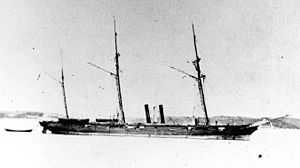CSS Florida (cruiser)
 CSS Florida | |
| Career | |
|---|---|
| Name: | "C.S.S. Florida" |
| Launched: | 1862 |
| Commissioned: | August 17, 1862 |
| Decommissioned: | October 7, 1864 |
| Fate: | Captured by United States; sunk in collision November 28, 1864 |
| General characteristics | |
| Length: | 191 ft (58 m) |
| Beam: | 27 ft 2 in (8.28 m) |
| Draft: | 13 ft (4.0 m) |
| Propulsion: | Sails and steam engine |
| Speed: | 9.5 knots (17.6 km/h; 10.9 mph) under steam, 12 knots (22 km/h) under sail |
| Complement: | 146 officers and men |
| Armament: | 6 × 6 in (152 mm) rifled cannons, 2 × 7 in (178 mm) rifled cannons, 1 × 12 pounder (5 kg) cannon |
- For other ships named Florida, see CSS Florida.
CSS Florida was a sloop-of-war in the Confederate States Navy.
Florida was built by the British firm of William C. Miller & Sons of Toxteth, Liverpool, and purchased by the Confederacy from Fawcett, Preston & Co., also of Liverpool, who engined her. Known in the shipyard as the Oreto and initially called CSS Manassas by the Confederates, the first of the foreign-built commerce raiders and naval warships was commissioned CSS Florida. The Union Navy's records long continued to refer to her as Oreto or to confuse her with CSS Alabama although, fitted with two funnels, she was readily distinguishable from single-stacked Alabama.
Florida departed England on March 22, 1862 for Nassau, Bahamas, to coal and contrived to fill her bunkers, although entitled only to enough to make the nearest Confederate port. She was the subject of much diplomatic correspondence.[1] The governor of Nassau drew the line, however, at an attempted rendezvous with her tender in Nassau harbor; so she transferred stores and arms at isolated Green Cay. There she commissioned as "C.S.S. Florida" on August 17, with veteran Lieutenant John Newland Maffitt, in command. During her outfit, yellow fever raged among her crew, in 5 days reducing her effective force to one fireman and four deckhands. In desperate plight, she ran across to the Spanish island colony of Cuba. There in Cárdenas, Maffitt too was stricken with the dreaded disease.
In this condition, against all probability, the intrepid Maffitt sailed her from Cárdenas to Mobile, Alabama. In an audacious dash the "Prince of Privateers" braved a hail of projectiles from the Union blockaders and raced through them to anchor beneath the guns of Fort Morgan in Mobile Bay for a hero's welcome by the war-weary citizens of Mobile. Florida had been unable to fight back not only because of sickness but because rammers, sights, beds, locks and quoins had, inadvertently, not been loaded in the Bahamas. Having taken stores and gun accessories she lacked, along with added crew members, Florida escaped to sea on January 16, 1863 under Captain John Newland Maffitt.[2]
After coaling at Nassau, she spent six months off the coast of North and South America and in the West Indies, with calls at neutral ports, all the while making captures and eluding the large Federal squadron pursuing her.
Florida sailed 27 July from Bermuda for Brest, France where she lay in the French naval dock from August 23, 1863 to February 12, 1864. There, broken in health, Maffitt relinquished command to Lieutenant Charles Manigault Morris. Departing for the West Indies, Florida bunkered (reloaded her coal bunkers) at Barbados, although the three months specified by British law had not elapsed since last coaling at a British Empire port. She then skirted the U.S. coast, sailed east across the Atlantic Ocean to Tenerife in the Canaries and thence back southwest to Bahia, Brazil, arriving October 4, 1864.
Anchored in the Brazilian haven, on October 7 Florida, while her captain was ashore with half his crew, was caught defenseless in an illegal night attack by Commander Napoleon Collins, of USS Wachusett (1861). Towed to sea, she was sent to the United States as a prize despite the Empire of Brazil's protests at this clear violation of their sovereignty. Commander Collins was court-martialed and was convicted of violating Brazilian territorial rights, but the verdict was set aside by U.S. Navy Secretary, Gideon Welles; Collins won fame and eventual promotion for his daring.
At Newport News, Virginia on November 28, 1864, Florida reached the end of her strange career when she sank under dubious circumstances after a collision with the USAT Alliance, a troop ferry. The sinking was most likely done at Admiral David Dixon Porter's encouragement, if not his orders. The Florida could therefore not be delivered to Brazil in satisfaction of the final court order, and could not rejoin the ranks of the Confederate States Navy.
Florida captured 37 prizes during her impressive career; her prizes which were absorbed into the C.S. Navy as CSS Tacony and CSS Clarence in turn took 23 more.
Today, many of the artifacts from CSS Florida are at the Hampton Roads Naval Museum .
References
- ↑ Appletons' annual cyclopaedia and register of important events of the year: 1862. New York: D. Appleton & Company. 1863. p. 381.
- ↑ Appletons' annual cyclopaedia and register of important events of the year: 1862. New York: D. Appleton & Company. 1863. p. 600.
This article incorporates text from the public domain Dictionary of American Naval Fighting Ships.
| ||||||||||